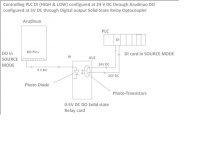Hello,
I have been reading online about optocouplers and solid state relays; I think I seem to have some misconception about their functions.
From what I know optocouplers are used to protect the internal circuitry of a plc what I am not sure about do they Step up and Step down the voltages ? if that is the case then would a motor be connected to an Optocoupler first before being connected to a PLC so as to prevent any reverse current from damaging the outputs ?.
Also would Solid state relays be able to control larger voltages say ( inputs for a PLC ) with a smaller control signal ? Please correct me if I am wrong.
Regards..
I have been reading online about optocouplers and solid state relays; I think I seem to have some misconception about their functions.
From what I know optocouplers are used to protect the internal circuitry of a plc what I am not sure about do they Step up and Step down the voltages ? if that is the case then would a motor be connected to an Optocoupler first before being connected to a PLC so as to prevent any reverse current from damaging the outputs ?.
Also would Solid state relays be able to control larger voltages say ( inputs for a PLC ) with a smaller control signal ? Please correct me if I am wrong.
Regards..





